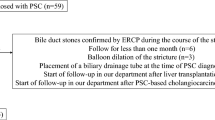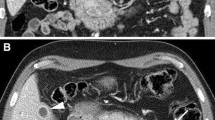Abstract
Aim
Primary sclerosing cholangitis (PSC) is a frequent complication in patients with inflammatory bowel disease (IBD). While hyperplasia of the perihepatic lymph nodes has been described in patients with PSC, its prevalence and cause in IBD patients remains obscure. In the present study we address the question of whether ultrasound (US) examination is useful to detect perihepatic lymphadenopathy and improve the diagnostic accuracy for PSC in patients with underlying IBD.
Methods
A total of 310 consecutive IBD patients were prospectively evaluated by US for enlarged perihepatic lymph nodes, as well as serologic testing for cholestasis-indicating enzymes. In patients with positive test results, viral or autoimmune liver disorders were excluded by serum testing. Next, the presence of PSC was confirmed/excluded by endoscopic retrograde cholangiography (ERC).
Results
Perihepatic lymphadenopathy was detected by US in 27 of 310 (9%) patients. In 9 (33%) of those, serologic testing identified an underlying autoimmune or viral hepatitis. In the remaining 18 patients, ERC confirmed PSC in 17 (94%) and excluded it in 1. Elevated cholestasis parameters were found in 43 of 310 (14%) patients and 5 (12%) of those were diagnosed with autoimmune or viral hepatitis. In the remaining 38 patients, ERC confirmed PSC in 15 (39%) and excluded it in 23 (61%). Therefore, when autoimmune or viral hepatitis was excluded, enlarged lymph nodes in US predicted PSC more accurately than conventional serum parameters alone (PPV 94 and 39%, respectively [ P<0.001]), and the sensitivity ratio increased by a factor of 1.13 in favor of the US examination.
Conclusion
In patients with IBD, detection of enlarged perihepatic lymph nodes is a highly predictive indicator for the presence of PSC. Alternative causes of perihepatic lymphadenopathy have to be excluded.




Similar content being viewed by others
References
Hanauer SB, Present DH (2003) The state of the art in the management of inflammatory bowel disease. Rev Gastroenterol Disord 3:81–92
Raj V, Lichtenstein DR (1999) Hepatobiliary manifestations of inflammatory bowel disease. Gastroenterol Clin North Am 28:491–513
Broome U, Glaumann H, Hellers G, Nilsson B, Sorstad J, Hultcrantz R (1994) Liver disease in ulcerative colitis: an epidemiological and follow up study in the county of Stockholm. Gut 35:84–89
Purrmann J, Modder U, Cleveland S, Seibold F, Burchard A, Gemsa R, Lubke H (1993) Association of primary sclerosing cholangitis with inflammatory bowel diseases: a prospective study. Z Gastroenterol 31[Suppl 5]:56–59
Aadland E, Schrumpf E, Fausa O, Elgjo K, Heilo A, Aakhus T, Gjone E (1987) Primary sclerosing cholangitis: a long-term follow-up study. Scand J Gastroenterol 22:655–664
Stockbrugger RW, Olsson R, Jaup B, Jensen J (1988) Forty-six patients with primary sclerosing cholangitis: radiological bile duct changes in relationship to clinical course and concomitant inflammatory bowel disease. Hepatogastroenterology 35:289–294
Riegler G, D’Inca R, Sturniolo GC, Corrao G, Del Vecchio BC, Di L, V, Carratu R, Ingrosso M, Pelli MA, Morini S, Valpiani D, Cantarini D, Usai P, Papi C, Caprilli R (1998) Hepatobiliary alterations in patients with inflammatory bowel disease: a multicenter study. Caprilli & Gruppo Italiano Studio Colon-Retto. Scand J Gastroenterol 33:93–98
Schrumpf E, Fausa O, Elgjo K, Kolmannskog F (1988) Hepatobiliary complications of inflammatory bowel disease. Semin Liver Dis 8:201–209
Fausa O, Schrumpf E, Elgjo K (1991) Relationship of inflammatory bowel disease and primary sclerosing cholangitis. Semin Liver Dis 11:31–39
Schrumpf E, Elgjo K, Fausa O, Gjone E, Kolmannskog F, Ritland S (1980) Sclerosing cholangitis in ulcerative colitis. Scand J Gastroenterol 15:689–697
Varghese JC, Farrell MA, Courtney G, Osborne H, Murray FE, Lee MJ (1999) Role of MR cholangiopancreatography in patients with failed or inadequate ERCP. AJR Am J Roentgenol 173:1527–1533
Wojtun S, Gil M, Gil J (2000) Recognition of ERC-induced pancreatitis in patients with choledocholithiasis by an analysis of laboratory findings. Hepatogastroenterology 47:550–553
Loperfido S, Angelini G, Benedetti G, Chilovi F, Costan F, De Berardinis F, De Bernardin M, Ederle A, Fina P, Fratton A (1998) Major early complications from diagnostic and therapeutic ERCP: a prospective multicenter study. Gastrointest Endosc 48:1–10
Majoie CB, Smits NJ, Phoa SS, Reeders JW, Jansen PL (1995) Primary sclerosing cholangitis: sonographic findings. Abdom Imaging 20:109–112
Oikarinen H, Paakko E, Suramo I, Paivansalo M, Tervonen O, Lehtola J, Aukee J (2001) Imaging and estimation of the prognostic features of primary sclerosing cholangitis by ultrasonography and MR cholangiography. Acta Radiol 42:403–408
Dietrich CF, Stryjek-Kaminska D, Teuber G, Lee JH, Caspary WF, Zeuzem S (2000) Perihepatic lymph nodes as a marker of antiviral response in patients with chronic hepatitis C infection. AJR Am J Roentgenol 174:699–704
Dietrich CF, Leuschner MS, Zeuzem S, Herrmann G, Sarrazin C, Caspary WF, Leuschner UF (1999) Peri-hepatic lymphadenopathy in primary biliary cirrhosis reflects progression of the disease. Eur J Gastroenterol Hepatol 11:747–753
Dietrich CF, Gottschalk R, Herrmann G, Caspary WF, Zeuzem S (1997) Sonographic detection of lymph nodes in the hepatoduodenal ligament. Dtsch Med Wochenschr 122:1269–1274
Johnson KJ, Olliff JF, Olliff SP (1998) The presence and significance of lymphadenopathy detected by CT in primary sclerosing cholangitis. Br J Radiol 71:1279–1282
Dietrich CF, Zeuzem S (1999) Sonographic detection of perihepatic lymph nodes: technique and clinical value. Z Gastroenterol 37:141–151
Dietrich CF, Zeuzem S, Caspary WF, Wehrmann T (1998) Ultrasound lymph node imaging in the abdomen and retroperitoneum of healthy probands. Ultraschall Med 19:265–269
Dietrich CF, Lee JH, Herrmann G, Teuber G, Roth WK, Caspary WF, Zeuzem S (1997) Enlargement of perihepatic lymph nodes in relation to liver histology and viremia in patients with chronic hepatitis C. Hepatology 26:467–472; Erratum (1998) 28:1444
Gottschalk R, Wigand R, Dietrich CF, Oremek G, Liebisch F, Hoelzer D, Kaltwasser JP (2000) Total iron-binding capacity and serum transferrin determination under the influence of several clinical conditions. Clin Chim Acta 293:127–138
Hirche H, Joeckel KH (2000) Advice for the statistical evaluation of means and percentages by confidence interval analysis. In: Ruebben H (ed) Uroonkologie. Springer, Berlin Heidelberg New York, pp 909–915
Rosner B (2000) Fundamentals of biostatistics, 5th edn. Thomson, Hamshire
Feinstein AR (1975) Clinical biostatistics XXXI. On the sensitivity, specificity, and discrimination of diagnostic tests. Clin Pharmacol Ther 17:104–116
Broome U, Olsson R, Loof L, Bodemar G, Hultcrantz R, Danielsson A, Prytz H, Sandberg-Gertzen H, Wallerstedt S, Lindberg G (1996) Natural history and prognostic factors in 305 Swedish patients with primary sclerosing cholangitis. Gut 38:610–615
Ponsioen CI, Tytgat GN (1998) Primary sclerosing cholangitis: a clinical review. Am J Gastroenterol 93:515–523
Wiesner RH, Grambsch PM, Dickson ER, Ludwig J, MacCarty RL, Hunter EB, Fleming TR, Fisher LD, Beaver SJ, LaRusso NF (1989) Primary sclerosing cholangitis: natural history, prognostic factors and survival analysis. Hepatology 10:430–436
Loftus EV Jr, Sandborn WJ, Tremaine WJ, Mahoney DW, Zinsmeister AR, Offord KP, Melton LJ III (1996) Risk of colorectal neoplasia in patients with primary sclerosing cholangitis. Gastroenterology 110:432–440
Angulo P, Lindor KD (1999) Primary sclerosing cholangitis. Hepatology 30:325–332
van den Hazel SJ, Wolfhagen EH, van Buuren HR, van de Meeberg PC, Van Leeuwen DJ (2000) Prospective risk assessment of endoscopic retrograde cholangiography in patients with primary sclerosing cholangitis. Dutch PSC Study Group. Endoscopy 32:779–782
Trap R, Adamsen S, Hart-Hansen O, Henriksen M (1999) Severe and fatal complications after diagnostic and therapeutic ERCP: a prospective series of claims to insurance covering public hospitals. Endoscopy 31:125–130
Johnson GK, Geenen JE, Johanson JF, Sherman S, Hogan WJ, Cass O (1997) Evaluation of post-ERCP pancreatitis: potential causes noted during controlled study of differing contrast media. Midwest Pancreaticobiliary Study Group. Gastrointest Endosc 46:217–222
LaRusso NF, Wiesner RH, Ludwig J, MacCarty RL (1984) Current concepts. Primary sclerosing cholangitis. N Engl J Med 310:899–903
Balasubramaniam K, Wiesner RH, LaRusso NF (1988) Primary sclerosing cholangitis with normal serum alkaline phosphatase activity. Gastroenterology 95:1395–1398
Outwater E, Kaplan MM, Bankoff MS (1992) Lymphadenopathy in sclerosing cholangitis: pitfall in the diagnosis of malignant biliary obstruction. Gastrointest Radiol 17:157–160
Warren KW, Athanassiades S, Monge JI (1966) Primary sclerosing cholangitis. A study of forty-two cases. Am J Surg 111:23–38
Dodd GD III, Baron RL, Oliver JH III, Federle MP (1999) End-stage primary sclerosing cholangitis: CT findings of hepatic morphology in 36 patients. Radiology 211:357–362
Ito K, Mitchell DG, Outwater EK, Blasbalg R (1999) Primary sclerosing cholangitis: MR imaging features. AJR Am J Roentgenol 172:1527–1533
Hubscher SG, Harrison RF (1989) Portal lymphadenopathy associated with lipofuscin in chronic cholestatic liver disease. J Clin Pathol 42:1160–1165
Bass NM, Chapman RW, O’Reilly A, Sherlock S (1983) Sclerosing cholangitis asociated with angioimmunoblastic lymphadenopathy. Gastroenterol 85:420–424
Thompson HH, Pitt HA, Lewin KJ, Longmire WP Jr (1984) Sclerosing cholangitis and histiocytosis X. Gut 25:526–530
Dodd GD III, Baron RL, Oliver JH III, Federle MP, Baumgartel PB (1997) Enlarged abdominal lymph nodes in end-stage cirrhosis: CT-histopathologic correlation in 507 patients. Radiology 203:127–130
Rabinovitz M, Gavaler JS, Schade RR, Dindzans VJ, Chien MC, Van Thiel DH (1990) Does primary sclerosing cholangitis occurring in association with inflammatory bowel disease differ from that occurring in the absence of inflammatory bowel disease? A study of sixty-six subjects. Hepatology 11:7–11
Acknowledgements
The authors thank H. Hirche, Department of Medical Informatics, Biometry and Epidemiology, University Hospital Essen, for statistical advice and critical review of the manuscript, and S. Dorn for excellent management of our ultrasound department.
Author information
Authors and Affiliations
Corresponding author
Rights and permissions
About this article
Cite this article
Hirche, T.O., Russler, J., Braden, B. et al. Sonographic detection of perihepatic lymphadenopathy is an indicator for primary sclerosing cholangitis in patients with inflammatory bowel disease. Int J Colorectal Dis 19, 586–594 (2004). https://doi.org/10.1007/s00384-004-0598-0
Accepted:
Published:
Issue Date:
DOI: https://doi.org/10.1007/s00384-004-0598-0




